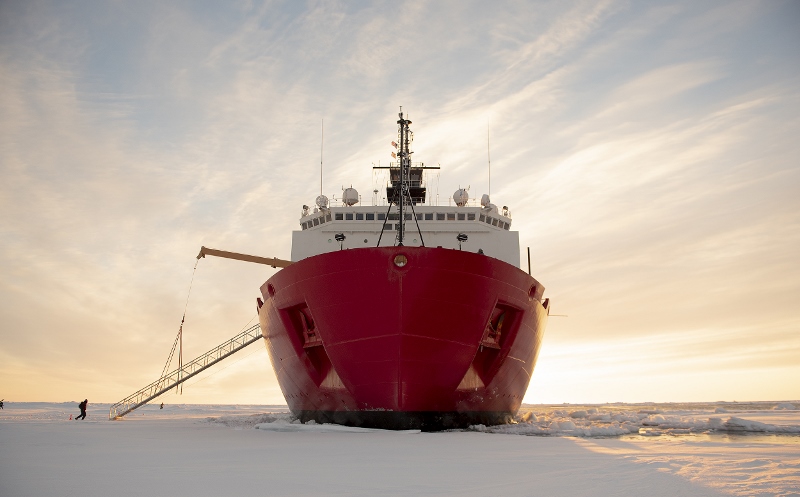The acquisition of a new polar icebreaker for the Coast Guard is just a small step toward achieving a better understanding of the Arctic’s ice melt, and more must be done by other sea services to position the U.S. in the region and respond to what officials believe is “a systematic and methodical increase in threats” to the country in the far north.
These are some of the conclusions of military experts at a forum held at the Navy League’s annual Sea-Air-Space exposition in Washington on Monday.
U.S. policy in the Arctic should be based on a “rules-based international order,” but year-round access to the Arctic makes the United States vulnerable to adversaries who can do harm to the country from the Far North, said Air Force Gen. Terrence O’Shaughnessy, who leads both the U.S. Northern Command and North American Aerospace Defense Command.
The U.S. needs to re-think its homeland defense strategy, the general said, as the Arctic becomes an arena for power and economic competition, especially from Russia, which has increased its military presence there and wants to partner with China to create a new sea route for cargo shipments between Asia and Europe. Russia is building three military bases and reviving others, with the possibility of placing cruise and long-range missiles there.
“That security environment has really changed,” O’Shaughnessy said, explaining that the U.S. is no longer a sanctuary, protected by oceans and other friendly countries. The Arctic is becoming “the first line of defense for North America and our potential adversaries want to bring the fight to us in North America.”
There’s also the potential ahead for conflict over the Arctic’s vast resources, he said. The region is believed to hold 13% of the world's undiscovered oil and 30% of its undiscovered gas, as well as uranium, rare-earth minerals, gold, diamonds and abundant fisheries.
“We’re not looking for conflict in the Arctic, but we must be prepared to operate in that space,” O’Shaughnessy said. And that means learning to operate in extreme weather conditions through training and joint exercises, develop equipment that can withstand the elements including satellite communications, continue to cooperate with Arctic-area countries and learn from the local people who have lived there for generations and witness daily the changes in the Arctic’s climate.
Officials also emphasized the importance of working with other Arctic nations that are competing in the area. Alaska sits just 44 miles across the Bering Sea from Russia, said Vice Adm. Daniel Abel, deputy commandant for operations, “so you must cooperate.” The U.S. already works closely with Canada, Norway, Finland and Russia on certain issues.
Abel said the Coast Guard has two icebreakers capable of working in these harsh conditions and Congress has approved funds to build a replacement for the aging Polar Star. The service says it needs six new vessels to up its game in the Arctic. Russia has the world’s largest fleet of icebreakers at 50, while China is building its first icebreaker.
The U.S. is also behind in understanding how the warming climate is affecting the Arctic’s unique weather fluctuations and patterns. Rear Adm. John Okon, commander of the U.S. Naval Meteorology and Oceanography Command, said that the ability of the U.S. to operate is hampered by a lack of weather modeling that can help ships, submarines and aircraft navigate through often-dangerous atmospheric events.
Collecting accurate data to run the modeling software in the extreme Arctic environment is key, the admiral said, and the “current amount of observations that we have in the Arctic are similar to the amount of observations we had over the U.S. and in the Atlantic during WWI.”
Okun said that the U.S. is currently “operating in the blind.” Many of the traditional sensors that provide weather observations in other locales don’t work in the Arctic’s climate, and there’s a need to develop better batteries for sea and air drones so they can function longer in cold temperatures.
Meanwhile, on the same day across the world in Finland, Secretary of State Mike Pompeo conveyed a different message at the eight-nation Arctic Council meeting. While defense officials in Washington openly linked climate change to the Arctic’s ice melt, Pompeo refused to acknowledge it as a factor and instead emphasized the positive economic impacts of the diminishing polar ice. The council meeting ended without a joint declaration because the U.S. wouldn’t agree on a text that included language about climate change, according to news reports.
“Steady reductions in sea ice are opening new passageways and new opportunities for trade,” the Pompeo said in a speech. “This could potentially slash the time it takes to travel between Asia and the West by as much as 20 days. Arctic sea lanes could become the 21st century’s Suez and Panama canals.”
Pompeo, did however, like those at the Washington forum, stress the national security concerns of the buildup of Russian and Chinese influence in the region.




